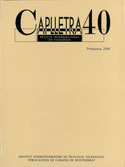Contraintes et libertés textuelles
DOI:
https://doi.org/10.7203/caplletra.40.4837Keywords:
genre Types (genres des texts), Type of speeches, textual Restrictions, textual Freedoms, Narrative, Praxeology, Expression of Temporality, literary Work Abstract
Abstract
The article starts from a conception of language according to which the semiotic units that speakers use do not emanate from individual mental processes but from the socialization of representation instruments which, being individual elements initially, have later been involved in processes of communicative circulation. In the same way that, in each language, verbal uses are limited by a series of restrictions in the constitution of some phonic, lexical or morphosyntactic structures, there are also some other constraints that affect textual genres. This means that these are the product of the history of the uses of language and that they work at a praxeologic level. These ideas apply to the study of expression of temporality in the story (récit) and in the narration (narration), with exemplification taken from real texts, mostly of literary character. Both in ordinary verbal work and in literary work, the freedom of the style works on
some pre-existent textual models which have to be known and mastered in order to adapt them to the specific conditions of each ordinary verbal action or literary production.
 Downloads
Downloads
Downloads
Published
How to Cite
-
Abstract281
-
PDF (Català)111
Issue
Section
License
Authors submitting work to Caplletra for publication must be the legitimate holder of the usage rights. Legitimacy for the purposes of publishing the work must also include images, tables, diagrams and any other materials that may complement the text, whether they are the author of such material or not.
Copyright: on publishing their work in the journal, the author grants Caplletra. Revista Internacional de Filologia usage rights (reproduction, distribution and public communication) for both the paper printed version and for the electronic version.
All work published in Caplletra is covered by the Creative Commons license type Attribution-NonCommercial-NoDerivatives 4.0 (CC BY-NC-ND 4.0).
RESPONSABILITY
Caplletra. Revista Internacional de Filologia does not necessarily identify with the points of view expressed in the papers it publishes.
Caplletra. Revista Internacional de Filologia accepts no responsibility whatsoever for any eventual infringement of intellectual property rights on the part of authors.






